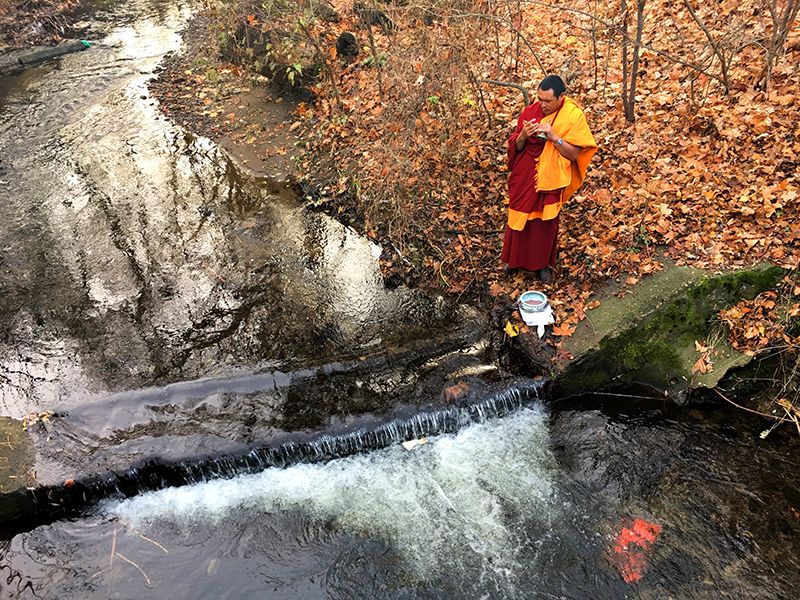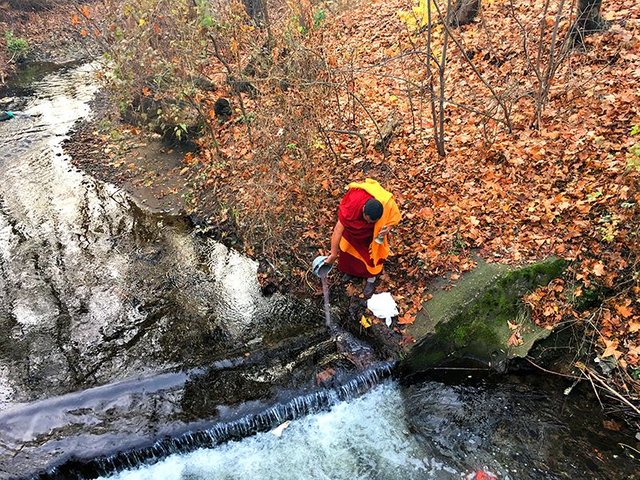SAND MANDALA-A Celebration Of The Impermanence In Life /photos & meaning/
We live in a world full of material values, no matter that the most important things in life such as love, friendship, deep connection, happiness are from a totally different nature.
The Tibetan Buddhism is a very old philosophy, which was strongly influenced by the even older tradition of Bon (It is almost indistinguishable from Tibetan Buddhism in terms of doctrines and rituals, but differs in the religious authority and history it accepts. The Tibetan people and rulers patronized the Bon religion through the eighth century CE, according to Bon belief, when royal support switched to Buddhism.).
The following mandala was created by Geshe Lobsang Soepa and his fellow monks Geshe Nima Tsering and Geshe Gyaltsen.
The Impermanence, also called Anicca or Anitya, is one of the essential doctrines in Buddhism. Anicca doctrine is one of the foundational premises of Buddhism, which asserts that all physical and mental events are not metaphysically real, that they are not constant or permanent, they come into being and dissolve.
There are two traditions in Tibetan Buddhism, which are strongly connected to the impermanence: 1-The sky burial, 2-The sand mandala (The main topic of my post).
The beginning of a mandala by Lama Ngawang Kunga Bista.
For Tibetan Buddhists, sky burial is an example of instructional teaching on the impermanence of life. Jhator is considered an act of generosity on the part of the deceased, since the deceased and his/her surviving relatives are providing food to sustain living beings. The Tibetan sky-burials appear to have evolved from ancient practices. These practices most likely came out of practical considerations, but they could also be related to more ceremonial practices similar to the suspected sky burial evidence found at Göbekli Tepe (11,500 years before present, it is a stone-age mountain sanctuary. Radiocarbon dating as well as comparative, stylistical analysis indicate that it is the oldest religious site yet discovered anywhere.) and Stonehenge (4,500 years BP).
One of my favorite cultural traditions is the Tibetan Buddhist Sand Mandala. I had the pleasure to photograph and film eight different sand mandalas created by monks.
Mandala is a Sanskrit word. In Tibetan they use the word ‘Chilkhor‘, Chil means ‘center‘ and ‘Khor‘ means ‘circumference‘. It denotes the complete cosmogram of the deity it represents. It is a spiritual and ritual symbol, diagrammatic picture, highly technical, architectural and precise, representing the universe, with the Mount Meru in the center and an idealized Tantric Buddhist, Hindu or Bon meditational Deity.
The mandala is "a support for the meditating person"
In modern days the sand mandala is made from hand colored sand. The monks create a mandala in 3-6 days. Every day they start with a prayer. A sand mandala is ritualistically dismantled once it has been completed and its accompanying ceremonies and viewing are finished to symbolize the Buddhist doctrinal belief in the transitory nature of material life.
A part of the sand is given to visitors, another part will be ritually put in a river (lake, moving water). This symbolizes the ephemerality of life and the world. The water brings the sand to the land, animals drink from the water, the rivers bring the water to the great ocean and other beings can become a part of the blessing, the sacred power of the ritual goes back to nature bringing peace, healing, compassion. There are many different kinds of a sand mandala, each one is created for a different reason, but they all bring something positive to the observers and the world.
This mandala was created by my friend Lama Ngawang Kunga Bista from the Kingdom of Mustang. He became a monk when he was only 3 years old. 10 years of his life as a monk were very far away from his family in India. 10 years without any connact with them. In that time he had a plan one day to open a school for poor children, so they can have education without becoming monks and leaving Mustang. At age 30 he reached his goal. Here you can read more about him and support his schools. http://www.himalayas-children.ch/de/schule-lama.html
Historically, the mandala was not created with natural, dyed sand, but granules of crushed colored stone. In modern times, plain white stones are ground down and dyed with opaque inks to achieve the same effect.
At the center of the mandala the syllable Hum is visualized, which characterizes the inner essence or composition of samsara (Human life embodies an aging process, the cycle of repeated birth and death, nothing lasts, and everything decays).
The symbolism of the mandala is the physical universe as samsara; the inner mandala is the body, speech, and mind of all sentient beings who inhabits this universe; the secret mandala is composed of the 84,000 thoughts which arise as ´mind´; and the inner secret mandala is innate self-revealed wisdom.


On my website you can find more information and many slideshows from different sand mandalas. Soon there will be also a video documentary. I am working on it.
http://bella-volen.com/sand-mandala-photo-gallery.html
All photos are by me, Bella Volen.
Good pics and great info
Thank you;), I am glad you like it.
Congratulations @bella-volen-art, this post is the sixth most rewarded post (based on pending payouts) in the last 12 hours written by a Dust account holder (accounts that hold between 0 and 0.01 Mega Vests). The total number of posts by Dust account holders during this period was 3245 and the total pending payments to posts in this category was $754.22. To see the full list of highest paid posts across all accounts categories, click here.
If you do not wish to receive these messages in future, please reply stop to this comment.